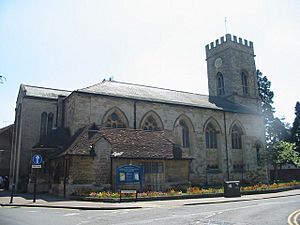- This page was last modified on 17 October 2025, at 10:18. Suggest an edit.
St Mary & St Giles Church, Stony Stratford facts for kids
| St Mary and St Giles' Church, Stony Stratford | |
|---|---|

St Mary and St Giles Church of England Church
|
|
| 52°3′25.2″N 0°51′12.9″W / 52.057000°N 0.853583°W | |
| OS grid reference | SP 78702 40464 |
| Location | Stony Stratford, Milton Keynes, Buckinghamshire |
| Country | England |
| Denomination | Church of England |
| Churchmanship | Anglo-Catholic |
| History | |
| Dedication | St Mary the Virgin and St Giles |
| Architecture | |
| Heritage designation | Grade II* listed |
| Architect(s) | Francis Hiorne |
| Completed | 1776 |
| Administration | |
| Parish | Stony Stratford with Calverton |
| Deanery | Milton Keynes |
| Archdeaconry | Buckingham |
| Diocese | Oxford |
St Mary & St Giles Church is a historic parish church located in Stony Stratford, a town that is part of Milton Keynes in Buckinghamshire, England.
Contents
Who Were St. Mary and St. Giles?
The church is dedicated to two important figures: St. Mary the Virgin and St. Giles.
- St. Mary is Mary, the mother of Jesus, a very important person in Christianity.
- Saint Giles was a saint born in Athens in the 7th century. He was known for his kindness and spent his life helping people who were suffering. Churches named after him were often built along roadsides, so that tired travelers could stop to rest.
A Modern Church with Deep Roots
The church is part of the Church of England and follows the Anglo-Catholic tradition. This means its services and style of worship include many traditions and ceremonies that are also found in the Catholic Church.
For some time, the church had a special arrangement for its leadership. However, on March 12, 2024, the church council decided to return to the main leadership of the local Bishop of Oxford.
The Church's Design and Features
The church building has a fascinating history and many beautiful features. It is a Grade II* listed building, which means it is officially recognized as a particularly important building of more than special interest.
The Ancient Tower
The oldest part of the church is its tower. It was built in the Perpendicular style, a type of English Gothic architecture popular in the late Middle Ages. The tower is 80 feet tall and has a clock and a set of six ringing bells. While the rest of the church has been rebuilt, the tower is the only part that remains from the original building.
Rebuilding the Church
In 1757, the chancel (the area around the altar) was in such bad condition that it had to be torn down and rebuilt. A few years later, around 1776, the rest of the church was also rebuilt by an architect named Francis Hiorne. Only the tower was saved from the old structure.
Inside the Church
The inside of the church is tall and spacious. One of its most striking features is the plastered, groined ceiling, which has a pattern of arches. This beautiful ceiling is held up by eight unique columns made of iron that are covered in wood.
In 1892, two new vestries (rooms for the clergy and choir to prepare for services) were added to the north side of the chancel. After they were built, the old vestry at the base of the tower was opened up to create a baptistry, the area used for baptisms.
Beautiful Windows and Art
The church has several stunning stained-glass windows.
- The large east window shows pictures of the 12 apostles, with their names written below each one. It was created in memory of a former church leader, Rev. W. T. Sankey.
- Another large window on the south side is dedicated to the memory of Josiah Michael and Ann Smith.
- There are also six smaller stained-glass windows under the galleries, dedicated to people from the church's past.
Near the vestry door, there is an old oil painting. A note on the frame explains that the painting and the gilded dove above it were part of the church's pulpit (a raised platform for preaching) in the 18th and 19th centuries.
The Church Organ
The first organ was installed in the church in 1812. The current organ has a more dramatic story. It was built by the famous organ maker ‘Father’ Henry Willis and was originally located in St George's Church in Edinburgh, Scotland.
After a small fire destroyed the previous organ at St Mary & St Giles, this historic instrument was brought to Stony Stratford in 1967. It was restored and is now cared for by the expert organ builders Harrison & Harrison.
The Churchyard
The churchyard contains many old gravestones. Interestingly, two of the flat gravestones for the Boyes family, who died in 1712, were moved from another old churchyard in the town, St. Mary Magdalene's, where the family members were originally buried.

